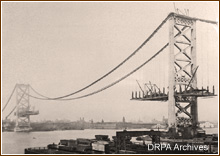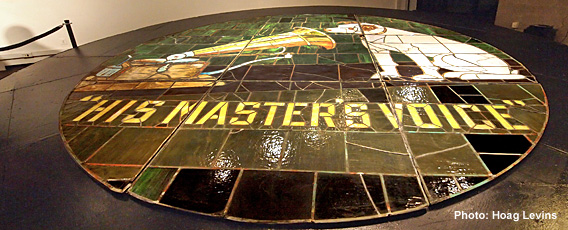|
Camden, N.J. -- One of the original "Nipper" windows that has served as the icon of the City of Camden for nearly a century is a highlight of the Rutgers University "Visions of Camden" exhibit that opened in the Stedman Gallery on Thursday. The display is a collaboration between the University and the Camden County Historical Society, which owns the window.
Created in 1916 by Philadelphia's famous D'Ascenzo Studios, the fourteen-foot circular stained glass art work is on extended

|
| 01.17.2013 -- The massive 'Nipper' window dwarfed the crowds at the opening reception of Rutgers University's 'Visions of Camden' exhibit in the Stedman Gallery. Larger |
display to the public for the first time in more than forty years. The glass mosaic depicts "Nipper" the dog in the "His Master's Voice" logo made world famous by the Victor Talking Machine Company that pioneered the music recording business in the opening decades of the 20th century.
"One of the Historical Society's greatest frustrations has been that we don't have a space large enough in our various buildings to put this incredibly historic treasure on permanent display," said Society President Sandy Levins. "We are very excited by this collaboration with Rutgers that enables us to make this touchstone of local history accessible to the general public again."
Delicate shape
She also noted that the window -- an intricate construction whose metal support matrix was seriously corroded by decades of exposure to the elements at the top of the RCA Nipper building tower -- is in delicate shape. "We are grateful for the care and efforts of Rutgers and everyone who pitched in to build the special horizontal platform that displays it in the 'Visions of Camden' gallery exhibit," said Levins.
The other three original "Nipper" windows are now in the collections of the Smithsoniam, Widener University and Penn State.
According to RCA historian and author of the definitive reference book of RCA history, Fred Barnum, each of the original four windows may be worth a six-figure sum as unique and irreplaceable historical artifacts with international significance.
Best and worst of Camden
In the Rutgers exhibit, which runs through March 1, the window is part of an extensive display of art works including vintage photographs, prints, maps, paintings, drawings and posters that recall Camden both during its heyday as an industrial hub of the Delaware Valley as well as today, when it is infamously known as one of the country's poorest and most violent cities.
Some of the most dramatic photographs are on loan from the Delware River Port Authority (DRPA), which used

|
| Included in the exhibit are dozens of photos from the Delaware River Port Authority archives documenting the construction of the Benjamin Franklin Bridge. Larger |
photographers to extensively document every step of the construction of the Benjamin Franklin Bridge. Hailed as an engineering marvel, it was the world's longest suspension bridge when it opened in 1926. Photographically dramatic in a very different way are photographer Ken Hohing's images of the controversial white crosses now planted in rows in the lawn in front of Camden's city hall. Each cross is marked with the name of one of the 67 who were murdered in 2012 -- most gunned down on the streets as victims of the city's vicious drug wars.
Artist Mickey O'Neill
More poignantly relevant to the positive aspects of life in Camden are the contemporary illustrations and paintings of Mickey O'Neill. O'Neill, a Camden-based oblate of St. Francis de Sales, is an accomplished fine artist whose works most frequently focus on religious themes and daily scenes of life that capture a sense of the personal joy and simple beauty that often goes unnoticed in hardscrabble urban communities like Camden.
"This Stedman Gallery exhibit offers -- and invites -- insights into Camden's past, its present, and its prospects," said Cyril Reade, director of the Rutgers-Camden Center for the Arts and a Rutgers associate professor of art history. "It proposes ways of envisioning moments in the history of the city, through the eyes of visual artists whose manipulation of color and form often return magic to the cityscape."
| 



